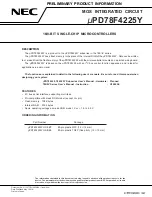
PSoC 6 MCU Ramping LED using Smart I/O
Document No. 002-25568 Rev.*A
2
Design and Implementation
This design consists of a PWM resource and a Smart I/O resource, both creating square waves of slightly different frequencies.
These square waves are routed through an exclusive-OR (XOR) gate within the Smart I/O resource, yielding a signal with a
gradually changing duty cycle. The rate of change is proportional to the difference between the output square wave frequencies.
The signal is then output to I/O4 of the Smart I/O port 9. Driving LED
with this signal results in a “ramping” effect, where the LED
gradually get brighter and dimmer alternately.
The PWM is driven by a 10-kHz clock with a period of 399 counts and a compare value of 200 counts. This gives a 50 percent
duty cycle square wave with a 40-ms period. The Smart I/O is clocked at 99 Hz using a divided clock sourced from CLK_PERI.
This input clock is divided by 4 using the lookup tables (LUTs) of the Smart I/O resource to produce a square wave with a
40.4-ms period.
To generate a square wave signal with a time period close to 40 ms, a 99-Hz clock is divided by 4 using a synchronous sequential
circuit, which is realized using the LUTs of the Smart I/O resource.
To implement a divide-by-4 sequential circuit, consider the state transition values shown in
Table 1. State Transition Table for a Divide-by-4 Sequential Circuit
CLK
Present State
Next State
D0
D1
Q0
Q1
Q0
Q1
0
0
1
1
1
1
1
1
0
1
0
1
0
1
1
0
1
0
1
0
0
0
0
0
From this state transition table, you can observe that Q0 is half the frequency of Clk_SmartIO and Q1 is 1/4
th
frequency of
Clk_SmartIO. This sequential logic can be implemented using the LUTs of the Smart I/O resource.
shows the implementation of this logic using LUT 2 and LUT 3. In addition, the divided clock is XORed with the PWM
output using LUT 4 to generate a signal with the duty cycle gradually increasing and decreasing over time. The output of LUT 4
is driven to I/O 4 output.



























